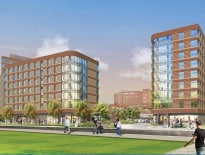The American Dream of homeownership is on life support, and who’s to blame?
Certainly not the Greatest Generation, which beat the Depression, trounced the Nazis and built the suburbs. Nor is it all those supposedly footloose, apartment-loving Millennials, drowning in student debt and battling to get a foothold in the dispiriting, post-Great Recession economy. And forget about blaming those erstwhile slackers, Gen X.
So yes, that leaves you, Baby Boomers.
Boomers spent their student days throwing temper tantrums in the streets, protesting everything from Vietnam to the supposed evils of American capitalism. But as they had children, settled down and bought homes in the suburbs they once derided, the Me Generation morphed into the NIMBY Generation, raising hell when anyone had the nerve to try to build anything, anywhere remotely nearby.
The degeneration of the American housing market into a brutal winner-take-all contest pitting a fortunate wealthy few against everyone else is often viewed through the lens of escalating, unsustainable home prices or the proliferation of luxury towers catering to the 1 percent. But at the heart of the crisis that is killing the American Dream is the steady decline in the construction of new homes, across the country but especially in hot, New Economy hubs like Greater Boston, San Francisco, San Jose and Seattle, among others.
And the biggest barrier preventing the market from supplying all the new homes desperately needed to meet demand and keep prices in check has been a seismic generational shift in attitudes towards new development. Simply put, while the Greatest Generation gave us new suburbs full of affordable Capes, ranches and colonials, their Boomer children have left us with McMansions and ever more restrictive NIMBY zoning.
Lessons From George Bailey
The post-war generation was happy to have survived 15 years of economic calamity and global war and was ready to enjoy the fruits of a booming economy, revived by World War II from its long slumber by the insatiable demands for production and armaments. And a wave of can-do entrepreneurs like developer William Levitt, the pioneer of suburban housing, rushed to meet the needs and demands of an expanding nation.
No one was under any illusion that profit making wasn’t at the heart of capitalism – and that capitalism could be rapacious. But business could also be an honorable pursuit, where one could make money and be of service to others. Think of George Bailey, the good guy banker in “It’s a Wonderful Life,” who truly cares about the people of Bedford Falls and whose bank is ultimately saved by the community.
But for the children of the ’60s, disillusioned by Vietnam and hating all things of their parents, Bailey was either a myth or a dupe of the establishment. The social activist was the new hero, standing in the way of greedy businesses and government schemes. No one in authority could be trusted; it was the job of the activist to ferret out the inevitable ulterior motive lurking behind every official pronouncement.
No Such Thing As A ‘Decent Developer’
Many Boomers may have gone on to buy homes in the suburbs and live comfortable, middle-class lives, but they never completely shed these attitudes, which continue to ooze out in perverse ways, especially when it comes to proposals by developers for new housing.
In the eyes of the Greatest Generation, like small-town banker George Bailey, builders performed a needed service, providing the housing needed for all those growing families and their little Boomer children.
But to Boomers, there is too often no such thing as a decent developer, striving like George Bailey to serve the community and make a few bucks; rather there is only greedy, rapacious builders looking to extract as many dollars as possible, the community be damned.
Taking a page from the lessons of their youth, Boomers have led the way in blocking new housing across the country, waging activist-style campaigns against new subdivisions and affordable apartment buildings alike.
Often it’s in the name of such lofty goals as “preserving” community character and pushing back against the evils of “density” and overdevelopment – twisted descendants of all that airy, feel-good, environmental activism of the 1960s.
But in the end, it’s just another way the Me Generation exposes its true self, looking out for No. 1 in the face of the (mistaken) belief that more homes and more families will push up school taxes and pull down property values.
It’s a selfish, I’ve-got-mine attitude that’s killing the housing market and hurting our country more than we realize.
Here’s hoping Gen Y takes its lessons on housing from the now-dwindling numbers of their Greatest Generation grandparents, not their Boomer moms and dads.




 |
| 





